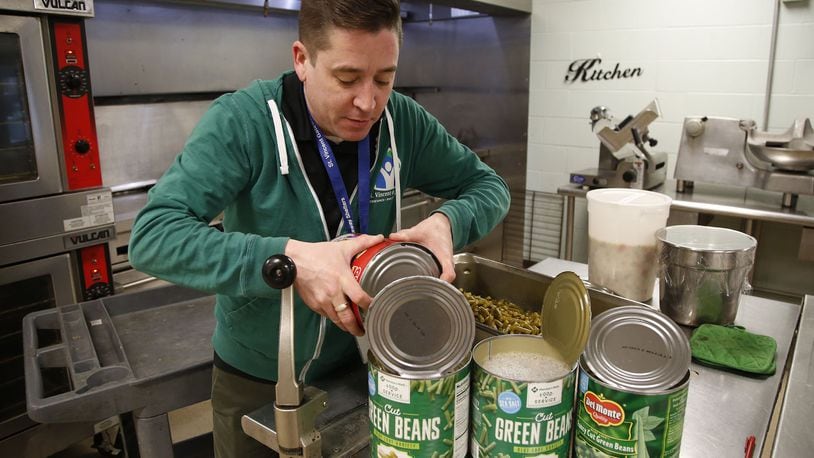The stock market improved over the last two years, the nation added jobs and tax changes left more money in the average consumers’ pay check, leading to more disposable income for many individuals.
“When you look at giving this year over last year, the reason it’s up for many people is unemployment is down, the stock market’s up, they have the money to give,” Parks said. “And if you have the money to give, most of us want to help a neighbor, we want to help our community, we want to make it a better place for our kids and grandkids, and we’ll do that.”
Donors who keep funds in the Dayton Foundation gave more than $37.1 million to nonprofits in the last half of 2018, 41 percent more than the same period in 2017.
»BIZ BEAT: First Wayfair store to permanently open Friday with big discounts
Giving follows the economy so closely that the rapid dip in the stock market in late December also caused a slowdown in new funds created, said Michelle Lovely, Dayton Foundation’s vice president of development.
Several other area charities saw jumps in donations in 2017 and 2018. YWCA received nearly double the number of in-kind donations in 2018 over 2017, said spokeswoman Audrey Starr. Goodwill in Dayton also saw a slight increase in philanthropic donations to programs, in-kind donations and foot traffic at stores, said donations manger Cindy Carusone late last year.
Both years brought in $2 million for St. Vincent de Paul in Dayton, which operates emergency shelters, a food bank and several programs to assist families in paying rent and utilities. That’s up from $1.7 million in 2015 and $1.8 million in 2016, said Michael Vanderburgh, executive director.
It’s been a good year for charities which get most of their revenue from individual donors, he said. Though the number of individuals who donated through the direct mail service increased only slightly, the average donation value increased 50 percent. Several nonprofit leaders said donations are affected by more than just the economy: marketing, donor matching and outreach also play parts.
While individual giving is up, corporations across the country haven’t given as much, Vanderburgh said.
In Dayton major corporations like NCR and GM have left the area or diminished their presence, resulting in fewer donations. The corporations with a larger presence are also giving smaller grants to each nonprofit because they’re spreading the funds out over a growing number of nonprofits.
Most of the United Way’s funding comes through campaigns at large employers. The group nationally has struggled to grow donations in recent years. Charity trends are changing — it’s as easy to give directly to charities than use organizations like the United Way as a go through, said Michael Squire, director of resource development.
»BIZ BEAT: New owner of Kettering grocery store started as bagger
But the United Way has worked to change its value to fund projects to improve the root of community concerns rather than use a bandage, Squire said.
Health and human services nonprofits like the United Way also don’t see as big of jumps as higher education and religious institutions do when donors increase giving, Squire said.
People tend to donate to causes visible in the news and those which market themselves through advertising, something small clinics can’t afford, said Sharon Sherlock, executive director of Dayton’s free clinic Reach Out.
Reach Out has held steady at $30,000 to $40,000 in donations each year, Sherlock said. The clinic needs closer to $100,000 to operate to the best of its ability.
»BIZ BEAT: Social media reports of abduction at local mall are false, leaders say
There are other concerns facing nonprofit leaders as effects from tax changes that started in 2018 still aren’t clear. With a higher standard deduction when filing tax returns, many donors are bundling their giving, or giving two to three years worth of donations in one year to get the tax break and claiming the standard deduction in the other years.
Some are concerned that the change could cause huge donations in some years, and then area nonprofits would go years without another gift.
In anticipation of the changes, the Dayton Foundation had more new funds created in 2017 than ever. The Foundation sets up charitable checking accounts that donors can put money into in one year and claim the deduction, then pay out to charities over several years, which could be a solution for many givers and nonprofits. Last year paced to have the second most funds created on record, along with the most grants paid.
“The question is what happens in a couple years and will they restock when their fund comes down. And I think a big part of that is what’s the economy doing at that time, Parks said.
FIVE FAST READS
• Things Remembered reportedly prepares to file bankruptcy, close stores
• Hepatitis A outbreak continues to grow in Ohio
• Niche store at The Greene to close later this month
• 5 ways potential Kettering Amazon delivery facility could speed up your delivery
•7 Super Bowl commercials that will have you laughing even after the game
About the Author
